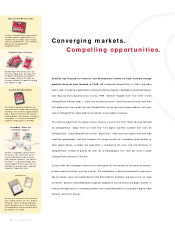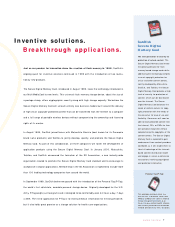SanDisk 1999 Annual Report Download - page 16
Download and view the complete annual report
Please find page 16 of the 1999 SanDisk annual report below. You can navigate through the pages in the report by either clicking on the pages listed below, or by using the keyword search tool below to find specific information within the annual report.
significant reduction in purchases by major customers, could have
a material adverse effect on our business, financial condition and
results of operations. See “Factors That May Affect Future Results
— Sales to a small number of customers represent a significant
portion of our revenues.”
All of our products require silicon wafers, which are currently
manufactured by UMC in Taiwan. Industry wide demand for semi-
conductors increased significantly in 1999, due to increased
demand in the consumer electronics and cellular phone markets.
This increased demand is expected to continue in 2000 causing
supply to become constrained and prices to increase. Under our
wafer supply agreements, there are limits on the number of wafers
we can order and our ability to change that quantity is restricted.
Accordingly, our ability to react to significant fluctuations in
demand for our products is limited. If customer demand exceeds
our forecasts, we may be unable to obtain an adequate supply of
wafers to fill customer orders, which could result in lost sales and
lower revenues. If we are unable to obtain adequate quantities of
flash memory wafers with acceptable prices and yields from our
current and future wafer foundries, our business, financial condition
and results of operations could be harmed. If customer demand falls
below our forecast and we are unable to reschedule or cancel our
wafer orders, we may end up with excess wafer inventories, which
could result in higher operating expenses and reduced gross mar-
gins. We have from time to time taken write downs for excess
inventories. For example, in the second quarter of 1998, our prod-
uct gross margins were negatively impacted by such an inventory
write down. These adjustments decrease gross margins in the quar-
ter reported and have resulted, and could in the future result, in
fluctuations in gross margins on a quarter to quarter basis. See
“Factors That May Affect Future Results — Our operating results
may fluctuate significantly.”
Export sales are an important part of our business, representing
53%, 56% and 57% of our total revenues in 1999, 1998, and
1997, respectively. Our sales may be impacted by changes in eco-
nomic conditions in our international markets. For example, in
1998, product sales to Japan declined 19% from the prior year, due
in part to the Asian economic crisis. While a majority of our rev-
enues from sales to Japan and other Asian countries are derived
from OEM customers who plan to export a portion of their products
to countries outside of Asia, economic conditions in Asia may con-
tinue to adversely effect our revenues to the extent that demand for
our products in Asia declines. Given the recent economic conditions
in Asia and the weakness of many Asian currencies relative to the
United States dollar, our products may be relatively more expensive
in Asia, which could result in a decrease our sales in that region. We
may also experience pressure on our gross margins as a result of
increased price competition from Asian competitors. While most of
our sales are denominated in U.S. Dollars, we invoice certain
Japanese customers in Japanese Yen and are subject to exchange
rate fluctuations on these transactions which could affect our busi-
ness, financial condition and results of operations. See “Factors
That May Affect Future Results —Our international operations make
us vulnerable to changing conditions and currency fluctuations.”
For the foreseeable future, we expect to realize a significant portion
of our revenues from recently introduced and new products.
Typically new products initially have lower gross margins than more
mature products because the manufacturing yields are lower at the
start of manufacturing each successive product generation. In addi-
tion, manufacturing yields are generally lower at the start of
manufacturing any product at a new foundry. To remain competitive,
we are focusing on a number of programs to lower manufacturing
costs, including development of future generations of D2 flash and
advanced technology wafers. There can be no assurance that we will
successfully develop such products or processes or that develop-
ment of such processes will lower manufacturing costs. In addition,
if the industry wide supply of flash memory products grows faster
than customer demand, we could experience increased price com-
petition in the future, which could result in decreased average
selling prices and lower gross margins. See “Factors That May Affect
Future Results — We must achieve acceptable manufacturing yields.”
Results of Operations
PRODUCT REVENUES.
In 1999, our product revenues increased 99% to $205.8 million from
$103.2 million in 1998. The increase consisted of an increase of
157% in unit sales, which was partially offset by a 22% decline in
average selling prices. In 1999, the largest increase in unit volume
came from sales of CompactFlash which represented 61% of product
revenues and MultiMediaCard products which represented 7% of prod-
uct revenues. A shift in product mix to higher capacity cards in 1999
partially offset a decline in the average selling price per megabyte of
capacity shipped. In 1999, the average megabyte capacity per unit
shipped increased 65% while the average selling price per megabyte
of flash memory shipped declined 52% compared to the prior year. The
mix of products sold varies from quarter to quarter and may vary in the
future, affecting our overall average selling prices and gross margins.
13
SanDisk Corporation
MANAGEMENT’S DISCUSSION AND ANALYSIS
























